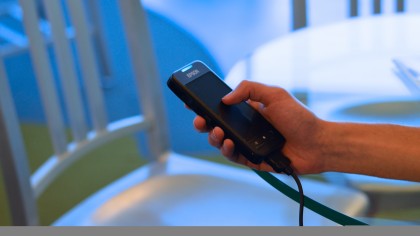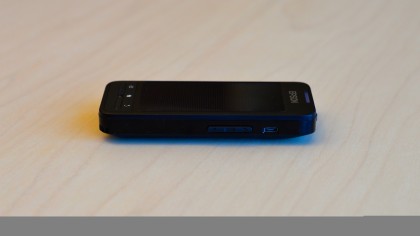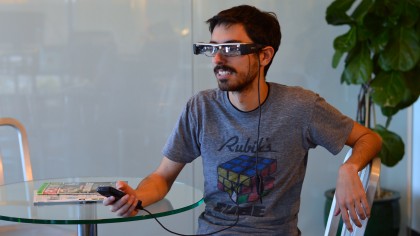Why you can trust TechRadar
The AR glasses run on a version of Android 4.0, which feels outdated when you first turn it on. It's still a familiar interface, so that is a relief. There wasn't any lag while navigating the main screen but there were definitely laggy spots during gaming.
Motion sensors detect your head's movements, and Dolby Digital surround sound pumps noise into your ears. There's also a front facing camera that lets you use augmented reality apps with it - though there aren't many apps you actually can use.

There's a textured touchpad the size of an iPhone 5 that lets you navigate the interface and plugs in via a proprietary connector. It can be disconnected for easy storage and is surprisingly responsive and light despite housing the battery, processor and other components.

Along with a micro USB charging port, a volume rocker can be found on the right side and a button that lets you adjust brightness, 2D/3D effects and volume within the interface lies on the left. A handy microSD slot also lives on the left. The top holds the power and lock button while the bottom has a home, list and back option.

Audio is available through a headphone jack on a clip on section of the wire between the touchpad and smart glasses.

I was able to secure the BT-200 better on my face with larger headphones, though Epson's included a pair of earbuds for your convenience.
Apps
The first Moverio was touted as a niche device that could be used in offices and by manual workers, like delivery people and field doctors. Those applications are still present, but now games and entertainment have entered the mix.
Sign up for breaking news, reviews, opinion, top tech deals, and more.
You can tune into Netflix or play mini games that involve the touchpad, but they're sparse and play more like demos. There's a Moverio Apps Market but again, the selection is slim.

YouTube also works in a knock-off app, but you can browse the web and read articles without too much fuss.
The games on the main screen of my BT-200 were clunky and got old quickly. Netflix works well enough, but the tiny display doesn't do movies or TV shows like Daredevil any justice.
I was told that many people with DJI drones were fans of the BT-200 app, because it allowed them to safely fly their drones. Apparently, a few companies are also testing out the real world applications as well. Aside from these two areas, it doesn't seem like there's a wider consumer appeal with the meager amount of apps available.
Battery life
The battery life has held up surprisingly well. Epson says the smart glasses last up to six hours depending on usage. The BT-200 went down to 55% through two days of testing involving gaming, watching Netflix and general exploring.

Recharging just involves plugging the touch pad into a micro USB wall socket and only takes a few hours to charge up. Since the smart glasses aren't doing anything too intensive, I'd say the battery could last more than a few days.
We liked
Though still a steep price, asking for $700 isn't too bad. That's especially considering Google Glass was $1,500 (£1,000, about AU$ 1,589).
There are also plenty of ways Epson has tried to make the smart glasses work, like including shades and a nose-guard. The battery life is also satisfactory, lasting me through a few days worth of testing.
We disliked
The general look of the BT-200 could be improved. The glasses simply aren't very comfy and look really silly. Frankly, I couldn't see anyone wearing these in public unironically.
The software is also in greater need of attention. Sure, it's familiar and easy to navigate, but seeing KitKat or even Jelly Bean would be an upgrade. Also, more apps. There's simply not much you can do without apps.
Final verdict
You can buy the Moverio BT-200 for $699 (£568, AU$849) right now, but that doesn't mean you should. It's meant for the enthusiasts and developer community more than anything, and really not worth picking up just yet.
With virtual reality hitting its stride and finally finding a place in the mainstream as worthy tech, augmented reality is still grasping for a foothold. The Microsoft HoloLens seems to be changing that and, with stronger design all around, Epson could probably get there too. Right now, the Moverio BT-200 smart glasses just can't cut it.
